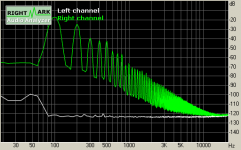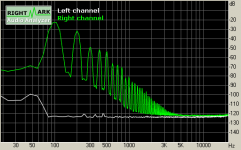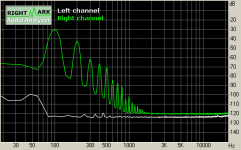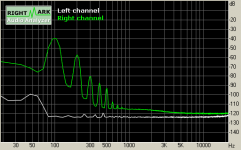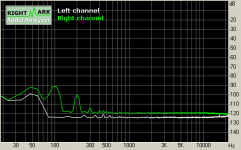Both MX-R and XA160 are power amps. But the 7th concept is universally valid, right?
If he wants to design based on a single figure, it is fine, but if he repeatedly blames other designs like AD797 based on this and untrue arguing (apples x oranges, distortion magnification), then it is just unfair.
If he wants to design based on a single figure, it is fine, but if he repeatedly blames other designs like AD797 based on this and untrue arguing (apples x oranges, distortion magnification), then it is just unfair.
Last edited:
I am blaming 'somewhat starved' IC amps, that use lots of negative feedback to 'linearize' them. It is the FEEDBACK that I worry the most about.
Look everybody, including PMA, use what you want, and please don't bother me about it.
The Blowtorch preamp has not been built for the last 5 years, and will never be built again. Please find your own audio 'nirvana', you don't have to scold me for your audio choices, and if you don't believe in my design philosophy, make your own! '-)
Look everybody, including PMA, use what you want, and please don't bother me about it.
The Blowtorch preamp has not been built for the last 5 years, and will never be built again. Please find your own audio 'nirvana', you don't have to scold me for your audio choices, and if you don't believe in my design philosophy, make your own! '-)
So why did you start off with the positive rail, then lurch over to the negative rail when it was demonstrated that the noise consequence with your 1968 chip was something less than the white noise left over from the Big Bang?
Your unit conversions are creative to say the least. And I see you went up another octave while you were at it. In any case, the impedance of a cheap (under a dollar in onesy-twoseys from Digikey, not 1968 vintage) 10,000 uF/25V aluminum electrolytic is under 50mohm. I'll let you work the numbers from there- can't wait to see what you come up with.
There are more productive horses to flog than this one, Ed.
SY
I am on a cell phone and the typos and auto spell drive me nuts
I thought I had posted the noise with 10000 uF of filtering. It shows a clear rise of rectifier noise in the upper midrange lower treble.
Now where did you get your 120 mV from?
The best power supply I posted was -120 dB re 1V.
I have been doing a lot of power supply measurements. From the same manufacturer there can be a great variance in performance. This was a bit of a surprise as expectations were for the usual extremely consistent quality.
I also used the AD 797 as an example because it has fairly good PSSR.
Now would you like to show your measurements of PSSR on a few different preamplifier designs? As you probably know in a real build you can approach the opamp limits but the rest of the circuit degrades it
Now how many tangents do you want to divert the issues to?
I started with the FFT of a simple power supply and so far no is willing to publicly even venture a guess as to the load.
Ed's use of 1968 components for examples, so even my numbers were enormously higher noise than you get from modern ICs.
Some amateurish measurements with 1968 components
White trace is the Big Bang noise ((loop-back signal of the card’s other channel)
http://www.diyaudio.com/forums/power-supplies/184068-psu-rc-multistage-filtering-2.html#post2486094
The spectrum emitted from the nearby power x-former can be picked up by the "clean DC" wires past the regulator and swamp anything else.
George
Both MX-R and XA160 are power amps. But the 7th concept is universally valid, right?
If he wants to design based on a single figure, it is fine, but if he repeatedly blames other designs like AD797 based on this and untrue arguing (apples x oranges, distortion magnification), then it is just unfair.
Pavel
It is an interesting question if the distortion weighting is the same for an amplifier as for a preamp. As the preamp is followed by a power amplifier it may be more important.
Now why JC prefers the sound of discrete designs to monolithic is an open question. As he leans to a single figure of merit, such explanations would follow. Now I suspect you and I would do the measurements at the actual operating point so see. Others will just argue aimlessly.
Now you may consider less than 100db S/N adequate. But as it is not masked by signal, others may find it a problem, particularly when it drops below 80.
Not to mention when it drops below 60, or even worse, 40.
Some amateurish measurements with 1968 components
White trace is the Big Bang noise ((loop-back signal of the card’s other channel)
http://www.diyaudio.com/forums/power-supplies/184068-psu-rc-multistage-filtering-2.html#post2486094
The spectrum emitted from the nearby power x-former can be picked up by the "clean DC" wires past the regulator and swamp anything else.
George
Thanks George
It was a bit fatiguing with all the noise from the paper results crowd.
ES
Thanks for this Mr. Marsh. YOu are entirely right.JC has said he belivevs there is more to better audio performance than only those numbers. There are other numbers and there are affects of materials, grounding, pcb artwork/layout and loading and interfacing etc etc etc. .... There is plenty to discusss besides comparing numbers only. Attention to a LOT of details makes a better product. At this point in the maturity of analog audio design - its all in the details.
Lets look at these details on the original JC2, the one with AD797 that was caned by the reviewers. JC was kind enough to share the circuit with us. It may give us a clue to JC's design philosophy.
The AD797 is used as a MM & MC preamp. It is entirely inappropriate for this purpose. The surrounding circuit degrades the usual Lo Z MC cartridge noise by at least 10dB. There is a similar degradation for MM cartridges but due to the choice of AD797.
AD797 is appropriate for only one type of rare MC cartridge but then the gain structure is completely wrong.
So here is a Golden Pinnae device, supposedly supa dupa matched with its 2 settings and getting them ALL wrong.
JC, did you do ANY calculations for noise? Did you MEASURE the noise? If you did, did you decide these figures weren't bad enough to upset your illustrious moniker on the front panel?
You may also like to compare the decoupling on JC2 with the recommendations on the datasheet. JC2's naive decoupling is likely to result in instability which will be difficult to see but will almost certainly result in poorer THD and intermodulation under certain signal conditions.
Without looking at the PCB and wiring details, its difficult to be sure .. but the schematic suggests inadequate attention and poor understanding of earthing for low noise & distortion.
All in all, JC2 Mk1 is the type of circuit produced by someone who failed Electronics 101 .. but believes a $zillion price tag, using Golden Pinnae parts without considering if they are appropriate (AD797) and a 'hand carved by virgins from solid Unobtainium' front panel guarantees sales.
To his credit, JC did change the AD797 for even more 'hand carved by virgins from solid Unobtainium' parts .. hopefully more appropriate for their role.
______________
JC, as for your pontificating on THD harmonics in class A, you really need to read Baxandall. Unlike you, he calculates AND measures it to confirm his theories.
______________
Attachments
kgrlee,
Now I await a reply to what you just wrote not from John but from Scott who can answer if what you just stated he is in agreement with.
Ps. I would still like to hear how you make a bad cd sound like anything but. I just put on an early transfer of a Doors album and I must say it sounds like crap.... Put on a Manhattan Transfer album and it was night and day. Anyone who says that all cds sound good with the correct equipment must not have a bad cd in the bunch. I know in this particular instance that the vinyl Doors album would just blow out the cd version, no comparison. I'll take the clicks and scratches over horrid cd sound any day. I guess that cd will make a nice coaster.
Now I await a reply to what you just wrote not from John but from Scott who can answer if what you just stated he is in agreement with.
Ps. I would still like to hear how you make a bad cd sound like anything but. I just put on an early transfer of a Doors album and I must say it sounds like crap.... Put on a Manhattan Transfer album and it was night and day. Anyone who says that all cds sound good with the correct equipment must not have a bad cd in the bunch. I know in this particular instance that the vinyl Doors album would just blow out the cd version, no comparison. I'll take the clicks and scratches over horrid cd sound any day. I guess that cd will make a nice coaster.
Thanks George
It was a bit fatiguing with all the noise from the paper results crowd.
ES
Paper results (e.g. ICs with better specs) are one thing to consider and implementation (layout, component orientation ect) is another.
I wrote above of the x-former emitted noise.
Attached are some spectrums from a sensing coil output, which was placed close to the x-former that was feeding the bridge/smoothing/regulator PCB.
I was recording the signal picked up while moving the coil, starting closest to the x-former and moving toward the circuit inch by inch.
George
>Edit: 1 inch, 2 inches, 3 inches, 4 inches, 6 inches
Attachments
Last edited:
This is the real heart of the matter -- the useless thrashing going on here about levels of something being -120 vs -100dB is totally irrelevant to getting good sound. If a car has crap suspension, then worrying about the right grade of titanium to use in the engine turbocharger is not going to do an ounce of good in making the car bearable to drive.Ps. I would still like to hear how you make a bad cd sound like anything but. I just put on an early transfer of a Doors album and I must say it sounds like crap.... Put on a Manhattan Transfer album and it was night and day. Anyone who says that all cds sound good with the correct equipment must not have a bad cd in the bunch. I know in this particular instance that the vinyl Doors album would just blow out the cd version, no comparison. I'll take the clicks and scratches over horrid cd sound any day. I guess that cd will make a nice coaster.
My approach in this situation is to say: right, the problem is not the recording, because all my experience tells me it is never the recording, or the transfer, but that a quality of the
system, we have to be "strong enough" to say it, a flaw in the playback mechanism is giving me "horrid cd sound"; the intrinsic, particular qualities of that recording are intermodulating in the worst possible way with a weakness in the reproduction chain.
So this is where the real battle starts, this is the garage mechanic being told that there is rattle somewhere in the car. Where? I don't know ... What's causing it? Haven't got a clue ... How am I supposed to I fix it? Just get rid of the noise, that's your job!!
The "bad" recording is your rattle, and you may have to tear the car completely to pieces to finally understand where that annoying, irritating noise is coming from. But believe me, it's somewhere there; you may punch holes in the wall with frustration trying to find it, but true understanding of the "bigger picture" finally emerges when you discover the cause ...
Frank
Frank,
That is just to say as just in the days of vinyl recording that nobody ever made a bad sounding album. If the next ten cd's that I play sound great does that mean I have a problem or the one bad sounding one is just that, a terrible remastering of the original source tapes? If I have a great car that runs great on gas from most gas stations and at one my car runs like hell, misses and fouls the fuel filter is it the car or the gas? Nothing like water in the gas to make your day, but I sure wouldn't say I need to figure out how to make it run on contaminated fuel. Same with a poorly transfer cd, to say they all are great is just nonsense.
That is just to say as just in the days of vinyl recording that nobody ever made a bad sounding album. If the next ten cd's that I play sound great does that mean I have a problem or the one bad sounding one is just that, a terrible remastering of the original source tapes? If I have a great car that runs great on gas from most gas stations and at one my car runs like hell, misses and fouls the fuel filter is it the car or the gas? Nothing like water in the gas to make your day, but I sure wouldn't say I need to figure out how to make it run on contaminated fuel. Same with a poorly transfer cd, to say they all are great is just nonsense.
Now where did you get your 120 mV from?
Quick sim in PSUD2. That gives very good results compared with experiment, thus its popularity.
So, managed to break the -200dB barrier yet?
I am on a cell phone and the typos and auto spell drive me nuts
I can't get my autocorrect to inadvertently change 10,000uF to 0.1F. Or 3kHz to 6kHz. What was the trick?
No, the point is not to make them sound "great". It is, for them not to have "horrid cd sound", there's a mighty big gap between those two extremes, and the "attitude" to have is, to get somewhere in that gap, preferably closer to the "great" end vs. the "horrid" end.Same with a poorly transfer cd, to say they all are great is just nonsense.
This said, I probably have your "bad" Doors CD album, I have 4 or 5 of them, and yes, I used them as reference pieces to work on some years ago. When my system was good they sounded very, very good; but when it was off-colour the sound of them was hideous ... I know what you're saying ...
I moved on to more testing material since: try live Ike and Tina Turner material at high volume to shred your eardrums when things aren't hunky dory ...
Frank
It's not marketing, SY, it is philosophising !
If "philosophizing" means "making unsupported and probably incorrect claims about competing technologies," and refusing to admit error and learning from the experience, then sure, you're philosophizing.
As you say, a "brilliant" recording can be "ruined" by the wrong turn of a dial. And to me that's a fault of the playback system. To use that miserable, dead horse, car analogy again it's like having unbelievably twitchy steering: if you concentrate like hell and turn the steering wheel in precisely the right manner, every time, the car performs very nicely and seems to be competent. But, if you over-correct even slightly, or turn the wheel a smidgin too quickly, disaster strikes - the car will skid and roll over ...The masters of the best sounding vinyls, if copied as-it on a cd, have all the chances to make a very aggressive and flat record.
To me that's unacceptable. The car should accommodate the vagaries of the road, and your inputs to controlling it, in an intelligent, comfortable and satisfying way. That's why companies like MB and BMW are winners ...
Frank
Many great vinyls were mixed in what we called 'magic rooms'. There where studios where the monitoring was far from flat (means dull) and obliged the sound engineer to add a lot of 'presence' (high medium) to their mixs to make a good sound in the studio.No, the point is not to make them sound "great". It is, for them not to have "horrid cd sound"
This presence compensate in odd that the vinyl will miss in even. But the tape sound very aggressive on flat CDs, Main reason for this 'CD sound' reputation.
I was smiling, looking to the response curves of the master tape recorder: After the mix down on the console, we used to correct-it listening "after tape". So the tape's character was part of the mix itself.
With digital recording, i'm not able to make the difference before/after tape.
Frank,
I guess we would have to define horrid cd sound to not disagree when we probably agree about the sound of a particular album. The Doors cd that I have just sounds like I am listening to a cheap stereo with terrible balance in the sound, no real bottom end to speak of and the top is irritating to say the least. Not complaining about noise or such, just a very bad mix and eq. Given the right mastering engineer I am sure it would have sounded much better, but I sure don't want something that sounds like it was mixed on a set of NC10 speakers and tested on a set of Auratones. Just believe me that this particular cd is poorly recorder.
I guess we would have to define horrid cd sound to not disagree when we probably agree about the sound of a particular album. The Doors cd that I have just sounds like I am listening to a cheap stereo with terrible balance in the sound, no real bottom end to speak of and the top is irritating to say the least. Not complaining about noise or such, just a very bad mix and eq. Given the right mastering engineer I am sure it would have sounded much better, but I sure don't want something that sounds like it was mixed on a set of NC10 speakers and tested on a set of Auratones. Just believe me that this particular cd is poorly recorder.
- Status
- Not open for further replies.
- Home
- Member Areas
- The Lounge
- John Curl's Blowtorch preamplifier part II
